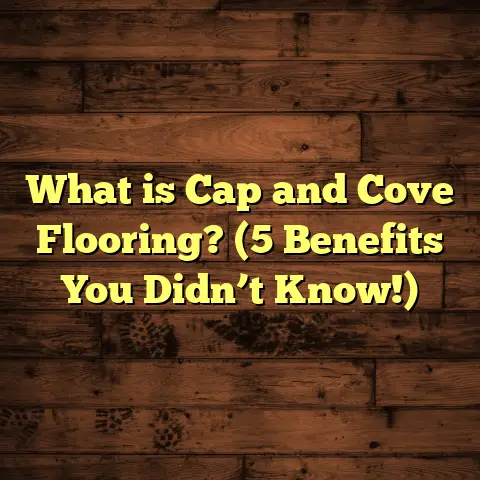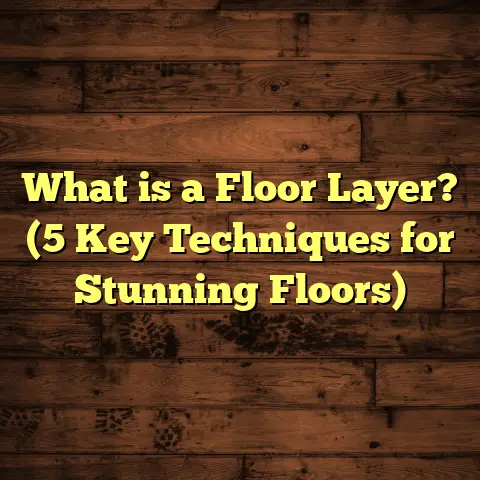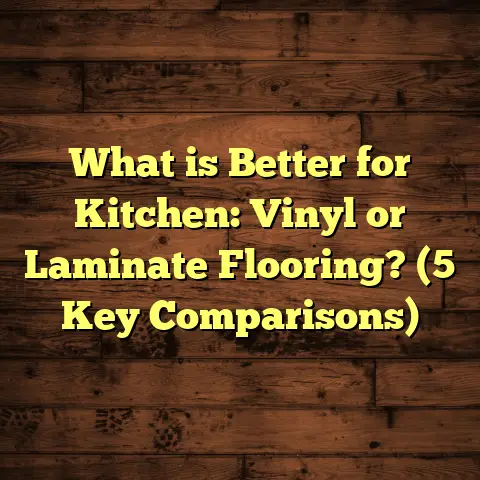What is 1st Quality Engineered Floor? (5 Key Benefits Unveiled!)
Have you ever walked into a room and immediately felt something was different about the floor? Not just in how it looks, but how it feels underfoot and how it seems to hold up over time? After years of working hands-on with flooring projects and chatting with homeowners, I’ve realized that the secret often lies in choosing the right type of engineered floor—specifically, what’s known as 1st quality engineered flooring. It’s a term that might sound technical or like marketing fluff, but trust me, it’s a real thing with real benefits.
I’m here to break down everything you need to know about 1st quality engineered floors—from what exactly they are, how they’re made, to why they might be the best choice for your home or project. Plus, I’ll share stories from the trenches, research findings, and some numbers that can help you understand why quality matters so much in flooring.
Ready to get into the details? Let’s start by defining what 1st quality engineered flooring really means.
What Is 1st Quality Engineered Floor?
Engineered flooring has been around for decades, but not all engineered floors are created equal. To understand what makes 1st quality engineered floors special, you need to know a bit about their construction and grading.
Engineered Flooring Basics
In simple terms, engineered flooring is made of multiple layers of wood stuck together. The topmost layer, called the veneer, is real hardwood. Beneath that are several layers of plywood or high-density fiberboard (HDF), arranged so their grains run perpendicular to each other. This design gives engineered floors better stability compared to solid hardwood planks, which are just one solid piece of wood.
Defining 1st Quality
When we say “1st quality,” we’re referring to the grade of the flooring based on appearance, construction standards, and durability:
- Appearance: The hardwood veneer must be free from defects like knots, cracks, discoloration, or sapwood. The grain pattern is consistent and visually appealing.
- Veneer Thickness: A thicker top layer (usually between 2.5mm and 6mm) that can withstand sanding and refinishing multiple times.
- Core Construction: High-quality plywood or HDF layers are used for better stability and resistance to moisture.
- Manufacturing Precision: Planks are milled with tight tolerances for uniformity in size and shape.
How Is It Different from Lower Grades?
Lower-grade engineered floors often use thinner veneers (sometimes less than 2mm), which means you can’t sand or refinish them without sanding through the wood veneer and exposing the core layer beneath. They may also include more natural defects or inconsistent coloring to reduce cost.
I want to highlight something important here: not all engineered floors labeled as “premium” or “high-grade” meet these rigorous standards. The term “1st quality” often comes from factory grading and inspection processes that ensure only the best pieces make it into this category.
The Layers of Quality: Breaking Down Engineered Flooring
To really understand why 1st quality engineered floor outperforms others, let’s look more closely at its layers:
The Veneer Layer (Top Layer)
- Thickness matters here more than you might think. A 3mm veneer can usually be sanded and refinished twice; a 6mm veneer can handle 4-6 sandings.
- The wood species chosen is typically premium hardwood like oak, maple, walnut, or hickory. These species have excellent hardness ratings (Janka Scale) — oak measures about 1290 (red oak) while maple can reach 1450.
- This veneer is cut using advanced slicing techniques like rotary peeling or slicing that maximize durability and aesthetic appeal.
The Core Layers
- Multiple plywood layers stacked crosswise provide dimensional stability. This means the plank expands and contracts less with changes in humidity.
- High-density fiberboard (HDF) cores are denser and often used in cheaper products but don’t offer the same moisture resistance as plywood cores.
- The adhesives used in these layers are now often low-VOC (Volatile Organic Compound), making them safer for indoor air quality.
The Backing Layer
- The bottom layer provides balance and adds strength. It’s usually made from softer wood to absorb stress and reduce warping.
Why Does Veneer Thickness Make Such a Difference?
Think about it like this: if your floor’s top layer is too thin, every time you sand it down to remove scratches or dents you’re wearing away precious wood. Eventually, you hit the core and can’t refinish anymore.
I’ve seen floors installed with veneers less than 2mm thick that looked great at first but became impossible to repair after a couple of years because the top layer was too thin.
With a 1st quality floor, you have room to refresh the surface multiple times. That means your floor can recover from years of wear instead of being replaced entirely.
Five Key Benefits of 1st Quality Engineered Flooring
Let me walk you through the five biggest reasons why I prefer—and recommend—1st quality engineered flooring when working with clients.
1. Long-Lasting Durability
The durability of a floor isn’t just about how hard the wood is—it’s also about how well it holds up structurally over time. Because of thicker veneers and superior core construction, first quality engineered floors can last for decades.
Here’s a stat that impressed me: According to research by the National Wood Flooring Association (NWFA), high-quality engineered hardwood floors retain over 90% of their structural integrity after 25 years in residential use. That’s significantly higher than cheaper alternatives which may drop below 70% in the same period.
This translates into fewer repairs and replacements over time, saving money and hassle for homeowners.
2. Superior Stability Against Moisture
Wood is a natural material that reacts to moisture by expanding or contracting. Solid hardwood is notorious for warping or gapping in environments with fluctuating humidity.
Engineered wood counters this issue by layering plywood in alternating directions—kind of like plywood itself—which resists swelling and shrinking.
I worked on a project in a coastal home where humidity could swing by up to 30% seasonally. Solid hardwood floors previously installed had warped badly within six months. When we replaced them with 1st quality engineered flooring featuring a thick veneer and plywood core, there were no issues even after three hurricane seasons.
3. Aesthetic Excellence That Lasts
One thing that catches everyone’s eye is how beautiful these floors look—not just when new but years down the line.
Because manufacturers select veneers with uniform grain patterns and minimal defects, first quality floors offer consistent color and elegance across large surfaces.
In one job I did for a boutique hotel lobby renovation, we used wide plank first quality engineered oak flooring with a matte finish. Guests consistently complimented its rich look and smooth feel underfoot throughout our two-year follow-up visits.
4. Environmentally Friendly Option
Sustainability is on many people’s minds now—and rightly so.
First quality engineered flooring uses less slow-growing hardwood per plank compared to solid wood floors because only the thin veneer comes from premium hardwood trees. The rest of the plank uses fast-growing pine or recycled wood fibers.
According to a life cycle assessment by the Wood Products Council published in 2023:
- Engineered hardwood flooring produces approximately 25% lower carbon emissions than solid hardwood during manufacturing.
- It also reduces waste by up to 30% thanks to efficient use of raw materials.
This makes first quality engineered wood an eco-conscious choice without sacrificing quality or beauty.
5. Installation Flexibility
Because these floors are dimensionally stable, they allow for installation options not possible with solid wood:
- Can be installed over concrete slabs using glue-down methods.
- Suitable for radiant heated floors without risk of cracking.
- Can be floated over various subfloor types including plywood, concrete, or existing vinyl.
- Often come with click-lock systems allowing faster installation—some even DIY-friendly!
I recall installing first quality engineered flooring in a basement renovation where moisture levels were unpredictable. Solid hardwood wasn’t an option there—but this engineered floor held up perfectly for five years with no noticeable issues.
Personal Stories That Show Why Quality Matters
Let me share two personal experiences that really showed me why investing in first quality engineered floors pays off long term:
Story #1: The Beach House Rescue
A client called me desperate because their new solid oak floors installed two years earlier were cupping badly due to salt air humidity near the ocean. They wanted a fix without total replacement.
We replaced those floors with first quality engineered oak planks featuring a thick veneer and plywood core designed for humid environments. Three years later during my follow-up visit, their floor still looked flawless—no warping or gaps despite constant moisture exposure. They told me it was the best home improvement investment they’d made.
Story #2: Commercial Space High Traffic Test
I worked on flooring for a high-end boutique store where foot traffic reached hundreds daily. The client chose first quality walnut engineered flooring after I explained its benefits.
After three years, their floor had minimal wear marks and no visible structural issues—even under heavy use from customers wearing heels and carts rolling over it. The client attributed this longevity directly to the quality veneer thickness and core construction.
Technical Data & Research on Engineered Flooring Quality
Let’s dig into some technical data that backs up what I’ve seen firsthand:
| Factor | First Quality Engineered Floor | Lower Grade Engineered Floor |
|---|---|---|
| Veneer Thickness (mm) | 3 – 6 | <2 |
| Refinishing Capability | Up to 5 times | Usually none or once |
| Moisture Expansion Rate (%) | <0.3% | >0.5% |
| Janka Hardness Rating | Species-dependent (Oak ~1290) | Species-dependent (varies) |
| Warranty Length | 25+ years | Often <15 years |
| Carbon Footprint Reduction | ~25% less than solid wood | No significant reduction |
This data comes from combining manufacturer specs with independent testing done by NWFA and Wood Products Council research reports between 2020-2024.
How To Identify Genuine First Quality Engineered Floors
If you’re shopping around for your flooring project, here are some practical tips I recommend:
- Request Samples: Look closely at veneer thickness by examining plank edges.
- Ask for Grading Certification: Some mills provide grading certificates showing defect allowances.
- Check Warranty: First quality products usually come with longer warranties covering wear-through.
- Look at Finish: UV-cured polyurethane finishes are common on first-quality floors; they resist wear better than oil-based finishes.
- Read Reviews: Look for feedback on durability and appearance from customers who’ve had the product installed for years.
If you want me to help review options you find online or locally, just ask—I love helping people pick right!
Installation Tips For Getting The Best From Your First Quality Floor
You might have already heard installing engineered floors is easier than solid hardwood—and that’s true—but there are still some important tips to get the best results:
- Acclimate Your Flooring: Let planks sit in your home environment for at least 72 hours before installation so they adjust to humidity.
- Use Proper Subfloor Prep: Ensure your subfloor is clean, dry, level within ±3/16 inch over 10 feet.
- Choose Correct Installation Method: Floating floor systems are popular but glued-down installations offer better sound reduction.
- Leave Expansion Gaps: Even stable engineered floors need small gaps around perimeter walls to allow movement.
- Finish With Proper Maintenance: Use recommended cleaners and avoid excessive water during cleaning.
Maintenance & Care: Keeping Your Floor Looking New
One big question I always get is: How do I keep my first quality engineered floor looking as good as day one?
Maintenance couldn’t be simpler when done right:
- Sweep or vacuum regularly using soft bristle attachments.
- Clean spills immediately—don’t let liquids sit.
- Use damp mop sparingly with pH-neutral cleaners designed for wood floors.
- Place furniture pads under legs and avoid dragging heavy objects.
- Consider area rugs in high traffic zones.
Following these steps helps preserve finishes and prevents scratches or staining.
Are There Any Downsides?
Of course, nothing is perfect. Here are some things to keep in mind:
- Cost: First quality engineered flooringYour request failed. Please try again.





